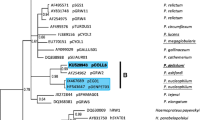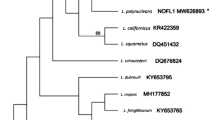Abstract
Haemocystidium papernai n. sp., a parasite of Agama nupta fusca in Sind, Pakistan produces large halteridial gametocytes in active infections that do not differ in morphology by sex. In chronic phase macrogametocytes are larger than microgametocytes. In Baluchistan, Agama nupta nupta is parasitised by Haemocystidium quettaensis n. sp. Gametocytes are smaller than those of H. papernai n. sp., round or oval in shape and heavily pigmented. Macrogametocytes are larger than microgametocytes and more heavily pigmented. Merogony of H. papernai n. sp. occurs in endothelium and connective tissue of lungs, heart, liver, spleen and femoral muscles. Meronts form as oval or rounded bodies that apparently are not preceded by the formation of “pseudocytomeres” that appear in the merogony of Haemoproteus spp. in snakes, turtles and birds. Meronts of Haemocystidium kopki were found in the lungs of the Pakistani gecko Teratoscincus scincus that were similar to those of H. papernai n. sp. The meronts of both species closely resemble phanerozoic meronts of saurian Plasmodium spp., and provide adequate justification for recognition of the genus Haemocystidium Castellani & Willey, 1904. Haemocystidium is distinguished from Plasmodium by the absence of an asexual cycle in circulating blood cells, and from Haemoproteus by meronts that do not form as pseudocytomeres. Sex ratios of H. papernai n. sp. varied from 22–47% microgametocytes, with no evident correlation with parasitemia, infection stage or month of collection, and H. kopki infections were comprised of 61–74% microgametocytes.
Similar content being viewed by others
References
Bogdanov, O.P., Markov, G.S. & Radchenko, N.M. (1970) [Blood parasites in Turkestanian agama.] In: Questions on morphology, ecology and parasitology of animals.] Volgograd, pp. 105–111. (In Russian).
Bouet, G. (1909) Sur deux hémocytozoaires pigmentés des reptiles. Comptes Rendu des Séances de la Société de Biologie et de ses Filiales et Associees, 66, 43–45.
Castellani, A. & Willey, A. (1904) Observations on the haematozoa of vertebrates in Ceylon. Spolia Zeylanica, 2, 78–92.
Cogger, H.G., Cameron, E.E. & Cogger, H.M. (1983) Amphibia and reptilia. In: Walton, D.W. (ed.) Zoological catalogue of Australia, Vol. 1, Canberra: Australian Government Publishing Service, 100 pp.
DeGiusti, D.L. (1965) Haemoproteus metchnikovi of chelonians, its tissue phase, peripheral parasitemia, host specificity and geographical distribution. In: Progress in parasitology, Proceedings of the Second International Conference on Protozoology, no. 199, p. 176.
DeMello, F. (1916) Quelques considérations sur les affinités zoologiques du genre “Haemocystidium” avec description d'une espèce nouvelle. Anais Scientificos da Faculdade de Medicina do Porto, 3, 33–39.
DeMello, F. (1934) Contribution à l'étude du cycle evolutif des Hameocystidium. Arquivos da Escola Medico-Cirurgica de Nova Goa, Serie A, 9, 1785–1799.
Dobell, C.C. (1910) Contributions to the life-history of Haemocystidium simondi Castellani et Willey. Festschrift Sechzigsten Geburstag Richard Hertwigs (Munchen). Vol.2. Jena: Verlag von Gustav Fischer, pp. 124–132.
Garnham, P.C.C. (1966) Malaria parasites and other Haemosporidia. Oxford: Blackwell Scientific Publications, 1114 pp.
Kimsey, R.B. (1992) Host association and the capacity of sand flies as vectors of lizard malaria in Panama. International Journal for Parasitology, 22, 657–664.
Levine, N.D. & Campbell, G.R. (1971) A check-list of the species of the genus Haemoproteus (Apicomplexa, Plasmodiidae). Journal of Protozoology, 18, 475–484.
Mackerras, M.J. (1961) The haematozoa of Australian reptiles. Australian Journal of Zoology, 9, 61–122.
Ovezmukhamedov, A. (1987) [Protistofauna of reptiles]. Ashkabad, Turkmen SSR: Izdatelstvo, 372 pp. (In Russian)
Paperna, J. & Landau, I. (1991) Haemoproteus (Haemosporidia) of lizards. Bulletin du Museum National d'Histoire Naturelle, serie 4, 13, 309–349.
Shortt, H.E. (1922) Review of the position of the genus Haemocystidium (Castellani and Willey, 1904), with a description of two new species. Indian Journal of Medical Research, 9, 814–826.
Shortt, H.E. (1962) Exo-erythrocytic schizont of Haemoproteus, parasite of the gecko Hemidactylus sp. in the liver. Transactions of the Royal Society Tropical Medicine and Hygiene, 56, 3.
Sterling, C.R. & DeGiusti, D.L. (1972) Ultrastructural aspects of schizogony, mature schizonts, and merozoites of Haemoproteus metchnikovi. Journal of Parasitology, 58, 641–652.
Telford, S.R., Jr. (1978) Intralymphocytic schizonts associated with an initial infection of Saurocytozoon tupinambi in Tupinambis teguixin. International Journal for Parasitology, 8, 133–138.
Telford, S.R., Jr (1982) Re-discovery of Haemoproteus kopki (De Mello, 1916) in two geckoes from the Afghan border of Pakistan. Parasitology 84, 527–536.
Telford, S.R., Jr. (1983) Saurocytozoon parasites (Haemosporidia, Plasmodiidae) from southeast Asian skinks. Journal of Parasitology 69, 1141–1145.
Telford, S.R., Jr (1984) Haemoparasites of Reptiles. In: Hoff, G.L., Frye, F.L. & Jacobson, E.R. (eds.) Diseases of amphibians and reptiles. New York: Plenum Publishing Corporation, pp. 389–515
Telford, S.R., Jr. (1988) A contribution to the systematics of the reptilian malaria parasites, Family Plasmodiidae (Apicomplexa, Haemospororina). Bulletin of the Florida State Museum, Biological Sciences, 34, 65–96.
Telford, S.R., Jr (1989) Discovery of the pre-erythrocytic stages of a saurian malaria parasite, hypnozoites, and a possible mechanism for the maintenance of chronic infections throughout the life of the host. International Journal for Parasitology, 19, 597–616.
Telford, S.R., Jr (1996) Epizootiology of the Japanese saurian malaria parasite Plasmodium sasai. Journal of Parasitology, 82, 226–232.
Wenyon, C.M. (1909; dated 1908) Report of travelling pathologist and protozoologist. In: Balfour, A. (Ed.) Third Report, Wellcome Research Laboratory at Gordon Memorial College, Khartoum. London: Bailliere, Tindall & Cox, pp. 121–168.
Wenyon, C.M. (1915) The pigmented parasites of cold-blooded animals, with some notes on a plasmodium of the Trinidad iguana. Journal of Tropical Medicine and Hygiene, 18, 133–140.
Wenyon, C.M. (1926) Protozoology: a manual for medical men, veterinarians and zoologists. Vol. II. London: Baillière, Tyndall & Cox, 784 pp.
Author information
Authors and Affiliations
Rights and permissions
About this article
Cite this article
Telford, S.R. Two new species of Haemocystidium Castellani & Willey (Apicomplexa: Plasmodiidae) from Pakistani lizards, and the support their meronts provide for the validity of the genus. Syst Parasitol 34, 197–214 (1996). https://doi.org/10.1007/BF00009387
Accepted:
Issue Date:
DOI: https://doi.org/10.1007/BF00009387




